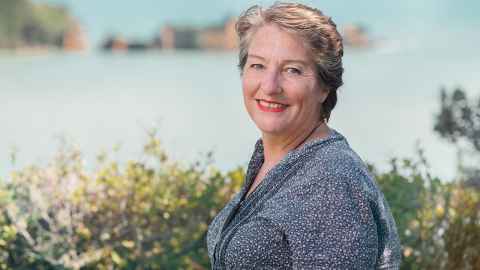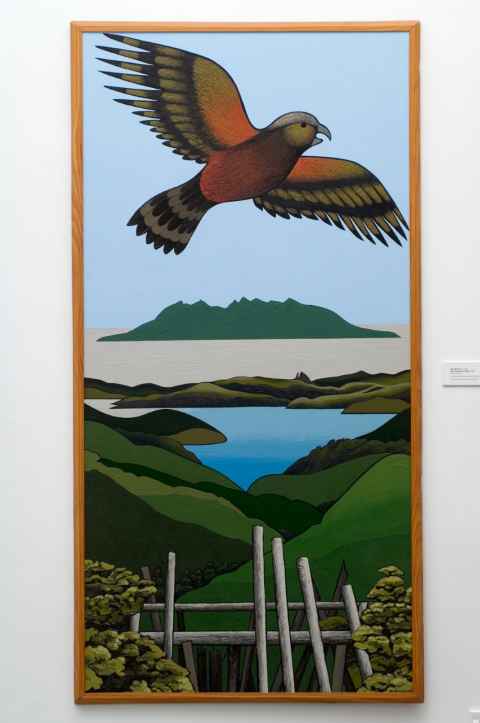Don Binney artwork perfectly positioned on campus
19 May 2023
Art historian Linda Tyler showcases a Don Binney artwork that's another of her favourites in the University of Auckland Art Collection.

Back last century when half a percent of the University’ of Auckland's construction budget was lavished on artworks for buildings, living artists were tasked with making new artworks for specific nooks and crannies around the campus.
For the new Auckland Medical School in 1975, art consultant Hamish Keith applied his art budget of $20,000 imaginatively, commissioning a floor numbering system using Roman numerals in black and yellow Perspex from a recently retired Fine Arts lecturer, Colin McCahon (1919-1987).
Another staff member, Pat Hanly (1932-2004), who had been a part-time drawing lecturer in the School of Architecture since 1962, rose to the occasion by painting a huge cycle of seven works dedicated to the Ages of Man.
Two years later, Hanly was asked to choose artists to contribute works to the Arts-Commerce building at 14a Symonds Street, designed by Ivan Mercep (1930-2014) of architectural practice Jasmad (later Jasmax). In contrast to Keith, Hanly got $140,000 to spend, and ensured there were as many female artists as male when he commissioned the 16 works in mid-1982.
The Arts-Commerce buildings on the City Campus are now known as Arts One and Two or Te Puna Tangata and Te Puna Reo, and they are occupied by the Schools of Humanities and Culture, Languages and Linguistics respectively, with Commerce decamping to its own edifice, the Sir Owen G Glenn Building, in 2005. Mercep designed the lift foyers for the display of art, with level three of Arts One getting the most traffic.
It is there that Don Binney’s Arts-Commerce Kākā (named by the artist) hangs, facing everyone who has to turn left to exit the building. In the five years I have worked in this building, I have looked at this painting several times a day, always engaged by the way the kākā is so perfectly positioned in the sky over the Kaiaraara Valley on Aotea Great Barrier Island, with Hauturu (Little Barrier) in the background.

Birds are big in Binney’s art, as they were in his life. The pioneer of modern birdwatching in New Zealand, Richard Broadley (Sibi) Sibson (1911-1994) was Binney’s Classics master at King’s College in Ōtāhuhu and was a huge influence on his protégé. Binney learned to draw birds as he saw them enlarged through binoculars. The artist’s vantage point here is from near the summit of Mount Hobson (Hirakimata) where he walked in November 1981, contemplating the old kauri dam used to transport the 30 million metres of kauri felled during the heyday of the timber industry – the commerce of the work’s title.
Binney has depicted the dam carefully, showing how it was designed to use a trapdoor system, where horizontal beams attached to vertically placed planks would swing open when the river pressure mounted under the force of a flood from a storm. Positioned at the bottom of the painting, the dam looks like a cage from which the kākā has escaped, spreading its wings in alarm.
Now, as we contemplate the devastating effects of flooding and the piles of slash left after timber felling, we can see the importance of Binney’s vision, and how his composition asks us to pay attention to Nature’s delicate balance.
Greg O'Brien book launch in October
Auckland University Press will launch alumnus Greg O’Brien’s book Flight Path on 19 October at 5.30pm in the lounge at Old Government House, where there are a number of Don Binney paintings from the University collection.
STORIES WELCOMED
Linda Tyler holds the David and Corina Silich Associate Professorship in Museums and Cultural Heritage. She is writing a book on the University’s Art Collection and invites stories from any interested alumni. Email: l.tyler@auckland.ac.nz
This article first appeared in the Autumn 2023 edition of Ingenio magazine.